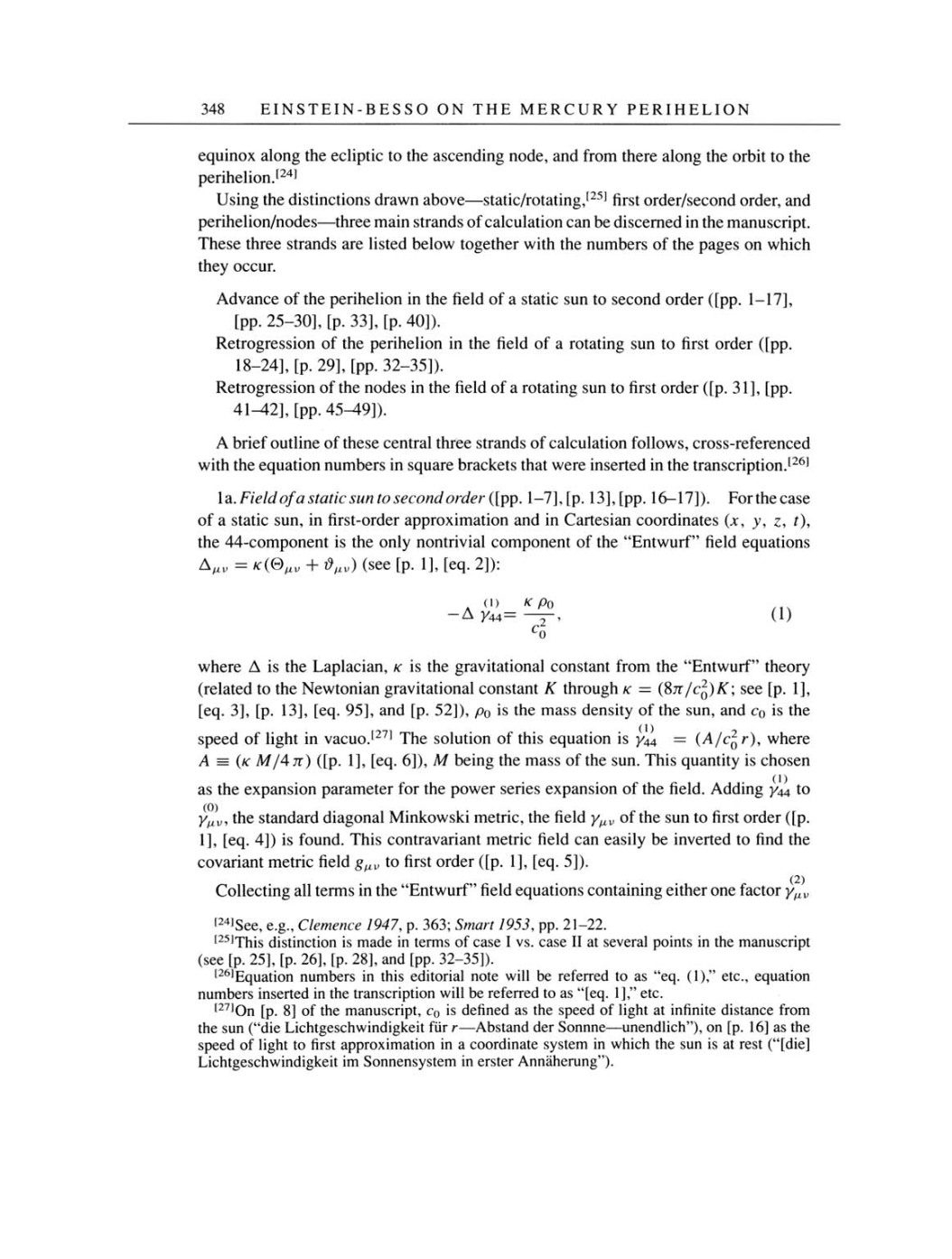348
EINSTEIN-BESSO ON THE MERCURY PERIHELION
equinox along
the
ecliptic
to the
ascending node,
and from there
along
the
orbit
to the
perihelion.[24]
Using
the
distinctions drawn
above-static/rotating,[25]
first order/second
order,
and
perihelion/nodes-three
main strands of calculation
can
be
discerned
in the
manuscript.
These three strands
are
listed below
together
with the
numbers of
the
pages
on
which
they
occur.
Advance of
the
perihelion
in the field
of
a
static
sun
to
second order
([pp.
1-17],
[pp.
25-30],
[p.
33], [p.
40]).
Retrogression
of
the
perihelion
in the field
of
a rotating sun
to first order
([pp.
18-24],
[p. 29], [pp.
32-35]).
Retrogression
of
the
nodes
in the field
of
a
rotating
sun
to first
order
([p. 31],
[pp.
41-42],
[pp.
45-49]).
A brief
outline of
these
central three strands of calculation
follows,
cross-referenced
with
the
equation
numbers
in
square
brackets that
were
inserted
in
the
transcription.[26]
1a.
Field
of
a
static
sun
to
second order
([pp.
1-7],[p. 13],[pp.
16-17]). For
the
case
of
a
static
sun,
in
first-order
approximation
and in
Cartesian coordinates
(x,
y,
z, t),
the
44-component
is the
only
nontrivial
component
of
the
"Entwurf"
field
equations
=
/c(0MV
+ ?V)
(see
[p. 1], [eq.
2]):
(1) K
-Aa
y44=
--,
(1)
co
where
A
is
the
Laplacian,
k
is
the
gravitational
constant
from
the
"Entwurf"
theory
(related to the
Newtonian
gravitational
constant K
through
k
=
(8n/c^)K; see [p.
1],
[eq. 3], [p. 13], [eq.
95],
and
[p.
52]),
p0
is the
mass
density
of
the
sun,
and
c0
is
the
speed
of
light
in vacuo.[27]
The solution of
this
equation is
y4\
=
(A/c2r),
where
A
=
(k
M/4tc)
([p. 1], [eq.
6]),
M
being
the
mass
of
the
sun.
This
quantity
is
chosen
as
the
expansion parameter
for
the
power
series
expansion
of the
field.
Adding
y^
to
y^v,
the
standard
diagonal
Minkowski
metric, the field
y^v
of
the
sun
to
first
order
([p.
1],
[eq.
4])
is
found. This contravariant metric
field
can
easily
be
inverted
to find the
covariant metric
field
g^v
to first
order
([p. 1], [eq.
5]).
Collecting
all terms
in
the
"Entwurf"
field
equations containing
either
one
factor
yßV
[24]See, e.g.,
Clemence
1947,
p.
363;
Smart
1953,
pp.
21-22.
[25]This
distinction
is
made
in
terms
of
case
I
vs.
case
II at several points in the manuscript
(see
[p.
25],
[p.
26],
[p.
28],
and
[pp.
32-35]).
[26]Equation
numbers
in this
editorial
note
will be
referred
to
as "eq. (1),"
etc.,
equation
numbers inserted
in the
transcription
will be
referred
to
as
"[eq.
1],"
etc.
[27]On
[p.
8]
of
the
manuscript,
c0
is
defined
as
the
speed
of
light at
infinite distance from
the
sun
("die
Lichtgeschwindigkeit
für r-Abstand
der
Sonnne-unendlich"),
on [p.
16]
as
the
speed
of
light
to first
approximation
in
a
coordinate
system
in
which the
sun
is at rest
("[die]
Lichtgeschwindigkeit
im
Sonnensystem
in
erster Annäherung").
